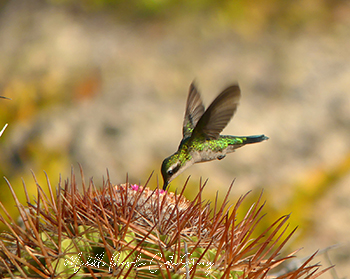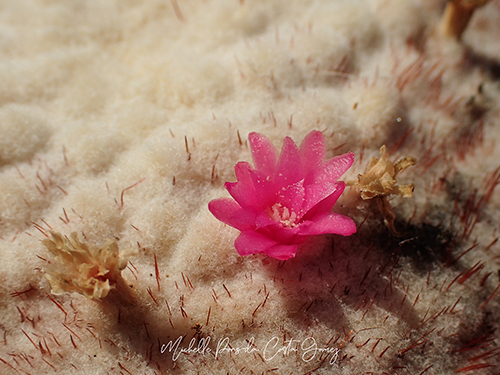The month of April marks the flowering of the Melocactus locally called Milon di seru or Bushi (Melocactus macracanthos). The photogenic plants can be found all over the islands of Aruba, Bonaire and Curaçao but do exceptionally well on the seemingly bare limestone terraces that can be found on all three islands, as well as other areas with almost no soil. With their long thin roots they search for water reservoirs in the limestone and can therefore easily withstand long periods of drought. The structure of the roots is also the reason why it is a very bad idea to pull the melocactus out of the ground to put in the garden. This will irreversibly damage the roots and the cacti will die, although that may take a year or two.
The Milon di seru already start forming the white ‘caps’ or ‘cushions’ in March that form white balls on top of the plants. This is called the cephalium. The structure of this is not as soft as it seems because there are sturdy spines in the white hairy mass. It is therefore not advisable to handle them with bare hands. The mini flowers (7-12 mm) with their beautiful pink colour form in the cephalium. The flowers, however small, are very rich in nectar and also produce a lot of protein-rich pollen. In addition to insects, there are also birds that gratefully use this delicacy in the dry season, such as hummingbirds and Bananaquits. The pink fruits are essential for the survival of our Cottontails (konènchi, on Aruba and Curaçao) and Sloke, the increasingly rare Crested Bobwhite (on Aruba and Curaçao) as well as all the endemic lizard species of the three island. However tasty they are, if you come across a cactus with fruits, do not pick them all, but leave the majority for wildlife.
English name: Melocactus
Papiamentu/Papiamento name: Milon di Seru/ Kabes di Indjan (Boniare, Curaçao), Bushi (Aruba)
Scientific name: Melocactus macracanthos
Family: Cactaceae (Cactusfamily)
Occurrence (ABC islands): Aruba, Bonaire and Curaçao (native)




Wilde bloemen – Melocactus macracanthos
De maand april markeert de bloei van de bolcactussen die lokaal Milon di seru of Bushi worden genoemd (Melocactus macracanthos). De fotogenieke planten zijn bijna overval op de eilanden Aruba, Bonaire en Curaçao wel te vinden maar doen het uitzonderlijk goed op de ogenschijnlijk kale kalkterassen en andere plekken met weinig vruchtbare aarde. Met hun lange dunne wortels gaan ze op zoek naar waterreservoirs in de kalksteen en kunnen daardoor lange perioden van droogte moeiteloos doorstaan. De structuur van de wortels is ook meteen de reden waarom het een zeer slecht idee is om de bolcactussen uit de grond te trekken om in de tuin te zetten. Daarmee beschadig je de wortels namelijk onherroepelijk, en gaan de cactussen dood, al duurt dat wellicht een jaar of twee.
De Milon di seru beginnen al in maart met het vormen van de witte ‘hoedjes’ of ‘kussentjes’ die als witte bollen bovenop de planten vormen. Deze wordt het cephalium genoemd. De structuur hiervan is niet zo zacht als het lijkt aangezien er in de witte harige massa stevige stekels zitten. Vastpakken met de blote handen is dan ook niet aan te raden. In het cephalium vormen zich de minibloemetjes (7-12 mm) met hun prachtige roze kleur. De bloemen zijn, hoe klein ook, zeer nectarrijk en produceren ook veel eiwitrijk stuifmeel. Naast insecten zijn ook vogels die dankbaar gebruik maken van deze lekkernij in de droge tijd, zoals kolibries en Suikerdiefjes. De roze vruchten zijn essentieel voor het voortbestaan van onze Cottontails (konènchi) (Op Aruba en Curaçao) en Sloke, de steeds zeldzamer wordende kuifkwartels (Op Aruba en Curaçao) en tevens alle endemische hagedissensoorten van de drie eilanden. Hoe lekker ze ook zijn, mocht je een cactus tegenkomen met vruchten, pluk die dan niet helemaal leeg.
Nederlandse naam: Bolcactus
Papiamentse naam: Milon di Seru/ Kabes di Indjan (Boniare, Curaçao), Bushi (Aruba)
Wetenschappelijke naam: Melocactus macracanthos
Familie: Cactaceae (Cactusfamilie)
Voorkomen (ABC eilanden): Aruba, Bonaire en Curaçao (inheems)


